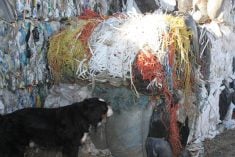Joyce Neufeld, of Waldeck, Sask., is a former national board member of the National Farmers Union.
For years, small communities have been struggling to keep their hospitals, schools and other businesses and services.
In 1958, Gull Lake, Sask., a typical rural community, had both elementary and high schools. Surrounding communities of Webb, Hazlet and Tompkins had elementary or elementary to high schools. There were also an additional 40 country schools in operation in the surrounding Gull Lake School Unit.
There were grocery stores, lumber-hardware stores, abattoir, meat market, several clothing stores, drug, shoe, and liquor stores, barber and hairdresser shops, five service stations, hotel/motels, five elevators, every machinery and car dealership available, hospital, two doctors, dentist, theatre and churches.
Read Also

Message to provincial agriculture ministers: focus on international trade
International trade stakeholders said securing markets in the face of increasing protectionism should be the key priority for Canada’s agriculture ministers.
During bonspiels, the local curling rink operated around the clock and rented ice at the skating rink also.
There was no shortage of young people for hockey, figure skating, baseball, softball, cubs, scouts, brownies, guides etc. Facilities were operating at full capacity. In other words, a typical vibrant rural community of the ’50s.
So, what has happened that many such communities have lost their hospitals, schools and most of these services?
Before these communities lost all of these, they lost something far more important in that they lost the means to sustain these services. They lost farmers.
In 1941 Saskatchewan had 138,713 farms, 1951 – 112,018, and 1991 – 60,840, a loss of 77,873 farm families or 56.14 percent.
Rural Economic Development Authority representatives are saying we need to attract small industry to rural Saskatchewan, but as the last Gull Lake machinery dealer said, “you can’t keep a business open when there are ever fewer customers coming through the door.”
The NFU thinks it is quite clear that we need policies to enable young farm families to return to the rural areas, and small business and industry will follow automatically. In 1991-92, NFU district 3 held a dozen public meetings to address concerns over the ever-increasing farm size and how it relates to the survival of rural communities.
Participants brought forth many ideas. First, beginning farmers must have access to land. Programs such as Saskatchewan Land Co-operative, community-based land trust, Land Bank, and Saskatchewan Lease Land programs must be combined and expanded to serve this need.
Dollar control of land means fewer and larger farms and fewer and smaller communities.
Next, the federal government must implement programs which would return, for example, $10 a bushel for the first 5,000 bushels of wheat marketed and $4.50 for the first 3,000 bushels of barley marketed, with prices indexed to inflation. This formula would be applied to all commodities, to give farmers a stable basic income.
Many other policy changes were suggested. Ideally all this would cost no more than the existing patchwork system of subsidies, crisis relief and ad-hoc job creation programs of today.
We believe it is in the best interests of all Canadians to keep the population of Canada spread out over the countryside. It is foolish to abandon the infrastructure that now exists on our farms and in our towns and villages only to be rebuilt in our cities. Cities are already finding difficulty in dealing with existing problems such as sewage treatment, garbage disposal and slum housing. Agriculture policies that encourage large corporate farms do not sustain rural communities.
Policies are needed to discourage ever increasing farm size before all rural communities are extinct. However, at the same time, these policies must ensure farmers a decent standard of living from the production of food.














